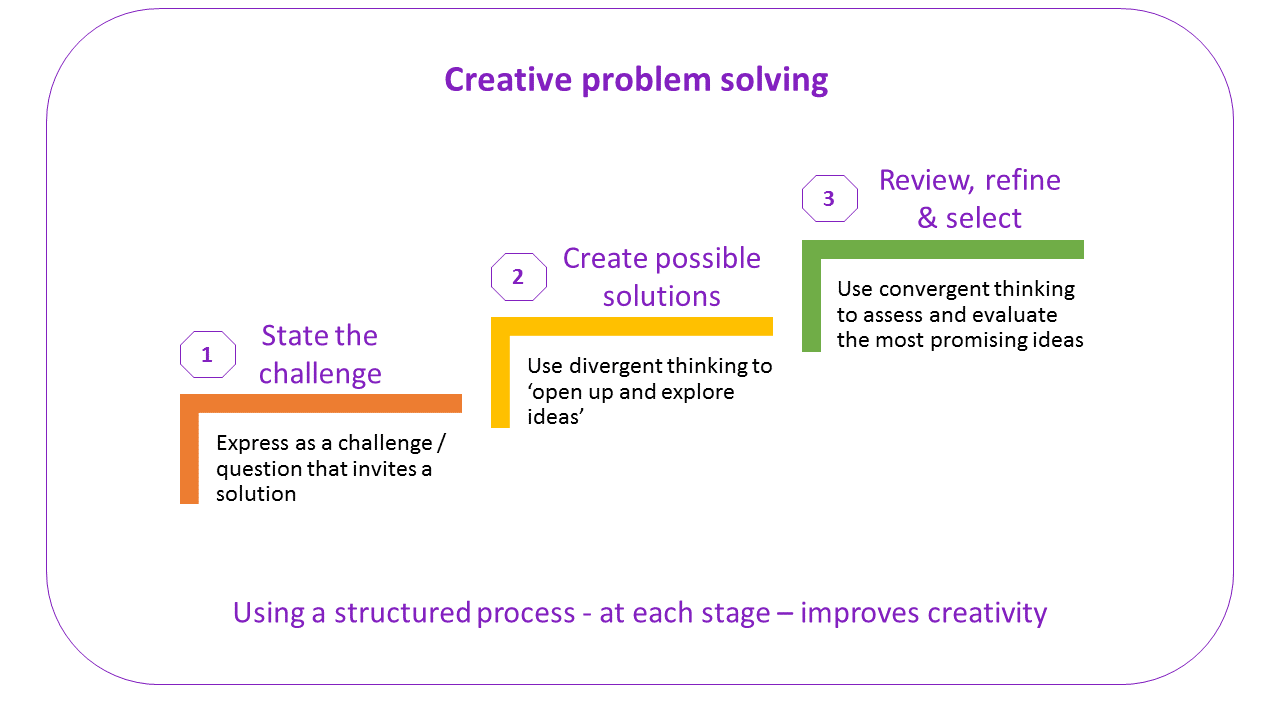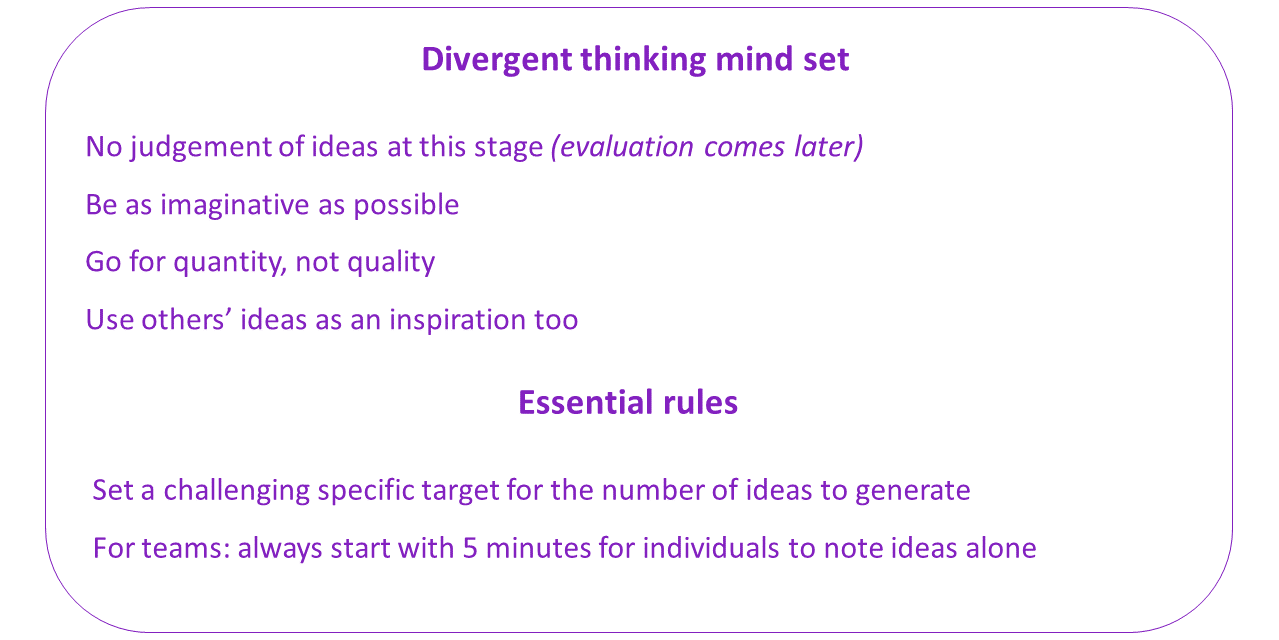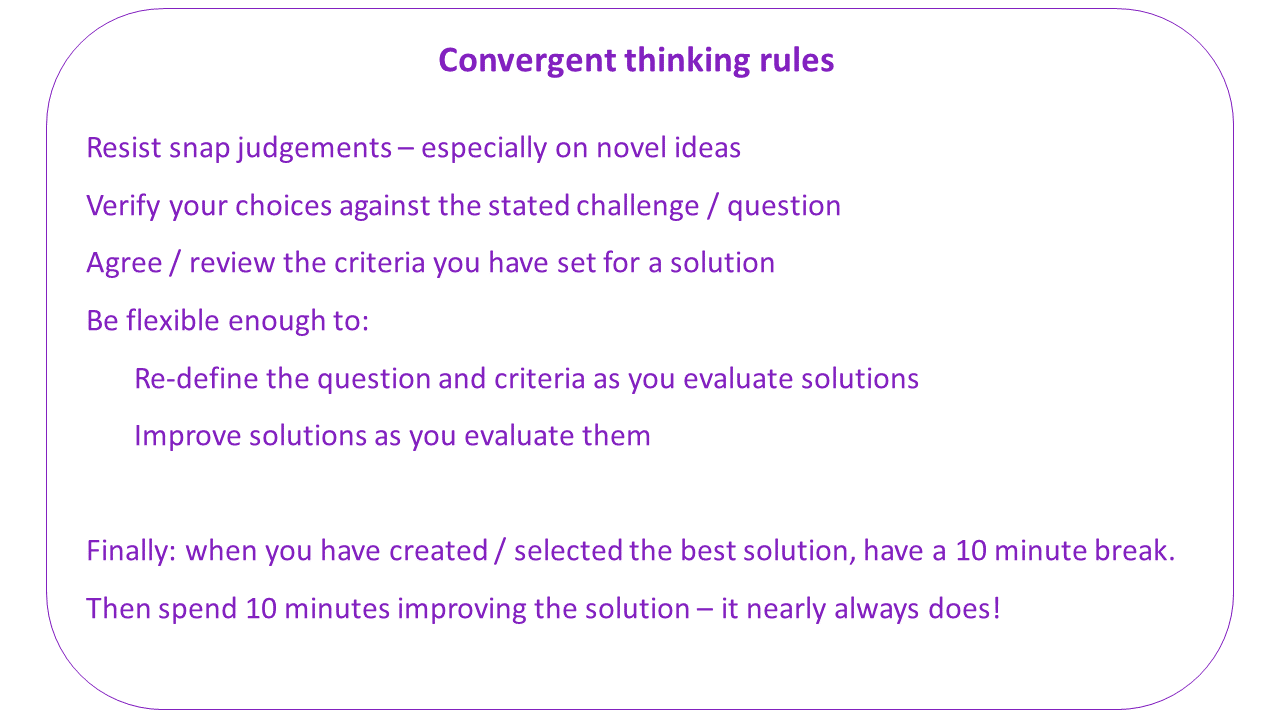Creative problem solving
-
 Overview
Overview -
 Exercises
Exercises
Overview
In practice: Applying an open-minded approach to problem analysis in a way that invites creative ideas and possibilities.
"The best way to have good ideas is to have lots of ideas and then throw away the bad ones" Linus Pauling
Creativity is ... the ability to produce work that is both novel (ie original, unexpected) and appropriate (ie useful, adaptive).1
Innovation is its practical implementation.
We need to be able to think creatively and innovate well. To help us with this we can break the creative problem solving process down into three stages2, each with its own characteristic approaches and evidence-based techniques.

Step 1: state the challenge
To be successful at creative problem solving we need, right from the start, to adopt an open-minded approach to what we might discover. There will be plenty of time at Step 3 - when we review, refine and select options - to consolidate our thoughts and eliminate unlikely solutions. But the approach for the first two stages should be as imaginative as possible.
The aim of the first step is to find a way of expressing the challenge facing the team (or you as individual if you are using this process on your own) in a way that invites you to explore solutions. Ideally in the form of an open question that will encourage the team to explore possibilities, rather than shutting them down.
(An open question is one that can't be answered by a tick in a box like yes or no, but needs a more descriptive answer; whereas a closed question is one where you choose between set options. An example of an open question would be "How might we improve our services to our over-65 users?", whereas "Should we open the helpdesk at 8:00am?" is a closed question that will tend to discourage creative problem solving.)
Here are some techniques and examples to transform a 'challenge' into a 'question that invites solutions':
The original challenge
- Some older people give our services poor ratings
Technique 1: Explore other words to describe the challenge
- "Our users deserve a better service"
Technique 2: Reframe the challenge as a question that invites solutions
- "How can we improve our services for the over-65s?"
Technique 3: Explore the data to re-focus the question
- "How could we make our services the best in the region for the over-65s?"
Exploring the data should also encourage the team to think imaginatively about the criteria that any solution will eventually have to satisfy. Thinking about the criteria, even at this early stage, will help to focus the question more clearly.
Step 2: create possible solutions
Once the question is formulated well - in a way that focuses on the right problem and is stated in a way that invites creative ideas - we move into the 'divergent thinking' stage. Divergent thinking is just a way of saying that we will be as imaginative as possible in creating possibilities. The 'baseline rules' for divergent thinking are often expressed as "No judgement, Be wild, Go for quality, Build on ideas".
These rules are fine in terms of creating a divergent thinking mind set, but there is now considerable evidence that you need to add two further rules for a team turn this mindset into good creative ideas. Without these extra rules team dynamics limit the creativity of the team to such an extent that you would be better just asking team members to go away and work on their own and send you their answers. Here's the full set:

The following techniques have evidence supporting their effectiveness as creative idea-generation processes. You can find out more about them and practice using them by clicking the Exercises tab at the top of this page.
- Brainstorming
- Brainwriting
- Mind Mapping
- Six Honest People
- Two Stakeholders
- Six Thinking Hats
- Viewpoints
Step 3: review, refine and select
At this stage we have a large number of ideas to consider. If the team has done the divergent thinking stage well the ideas should range from the promising and feasible to the fairly ridiculous. There will also be several ideas that are identical to each other, some that can be grouped together into a single potential solution.
We also have at least an initial idea of the criteria we want any solution to meet, from Step 1.
The task now is to refine our criteria, so we know more precisely what we are looking for, and then to reduce the ideas to the most promising and start some serious analysis to find the best.
The 'rules' for this convergent thinking stage are quite different from the divergent thinking rules.

This stage can itself be broken down into five distinct steps: (1) checking you have the right criteria that you want your solution to meet (2) scanning through all the ideas you have come up with (3) picking a few with the most potential, for further discussion and analysis (4) tidying them up, grouping ideas together and improving them, so that you have two or three serious options to assess, and finally (5) evaluating the best options against your criteria, and making your choice. This process can take anything from less than an hour for a fairly straightforward decision, to several weeks if you have to research more information, ask for stakeholder views and so on. The process is described more fully in our 'Choosing the best solution' section.
1. Creativity definition based on Sternberg, R.J. 1999 Handbook of creativity, Cambridge University Press, 1999
2. For a great resource on creative problem solving, see Creative Problem Solving Resource Guide, Creative Education Foundation, 2014
Exercises
Exercise - Brainstorming
Most people run a brainstorming session in a way that has been proven NOT to work in terms of producing creative ideas. This exercise shows the correct way, and the evidence behind it.
Exercise - Brainwriting
A more recent alternative to brainstorming, which has good evidence that it works to generate creative ideas.
Exercise - Mind mapping
Mind mapping helps you to note down ideas and link them together visually.
Exercise - Six honest people
Derived from Rudyard Kipling's poem "I keep six honest serving men ... " this technique helps you to explore any situation by asking six simple questions.
Exercise - Two stakeholders
This creative problem solving technique has been designed and tested in the software development world, but is just as applicable to any team looking for a way to generate creative options - especially where stakeholder views are important.
Exercise - Six thinking hats
Six thinking hats is one of the most well-known tools for creative thinking, with some evidence that it can help to generate richer, more creative solutions to problems.
Exercise - Viewpoints
Exploring a problem from different viewpoints can help to improve creativity1. Shown below are some different viewpoints you could use to stimulate your thinking.
Exercise - Selecting the best option
This exercise shows you / your team the best way to select the best option after a creative session where you / your team have produced several ideas. It can also easily be adapted for day-to-day team decisions.
